Transformers: Metal Machinery Breaks the Mold
The versatility of today’s metal forming machinery doesn’t end with the shaping of metal.
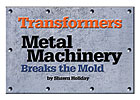
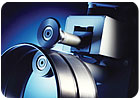 The versatility of today’s metal forming machinery doesn’t end with the shaping of metal. Fabricating architectural sheet metal into precision components has transformed the metal roofing industry into one of the most vertically integrated segments in construction. Like the days of old, roofing contractors are able to provide customers with reliable, high-end products that they manufacture, in their shops or on the jobsite.
The versatility of today’s metal forming machinery doesn’t end with the shaping of metal. Fabricating architectural sheet metal into precision components has transformed the metal roofing industry into one of the most vertically integrated segments in construction. Like the days of old, roofing contractors are able to provide customers with reliable, high-end products that they manufacture, in their shops or on the jobsite.
A tightening construction market makes that versatility more important as innovation continues to simplify training and upgrading. High-tech computer controls and Internet diagnostics allow technicians to turn out quality panels and flashing with a few keystrokes and service the machine as well.
“These are some of the biggest changes in the industry,” said Rick Wester, vice president of RAS Systems, LLC in Peachtree, Ga. (www.ras-systems.com). “The computer with the aid of codes, like bar coding, makes the transfer of information to the machine very simple and this eliminates errors in production.”
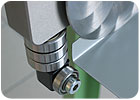
“Contracts want to be in charge of the manufacturing cycle so they can be in charge of the construction cycle,” said Geoff Stone, president of MetalForming Inc. in Peachtree, Ga. (www.metalforming-usa.com). “Contractors are more and more becoming manufacturers.”
MetalForming built a business on showing the profitability of a sheet metal shop with folders, roll-formers and shears, even breaking the cost of machines into an hourly rate. The tremendous popularity of architectural metal roofing in a booming construction market ensured a large customer base. Now when it seems customers are taking a breather, the metal roofing market is once again changing form to meet consumer demands.
Although he says the last quarter was the company’s best ever, Stone is addressing a lower price point in current customers by retrofitting existing machines. This “extreme makeover” involves taking an old Schechtl or Jorns machine and installing a Pathfinder controller, touch-screen monitor and advanced graphic programming. The result is a fully networked machine that can form thousands of components. Stone says the company has also refurbished a backlog of trade-ins for substantial savings over new models.
MetalForming is also using computers for the integration of management software and accessing the Internet for training new customers, a requirement for each purchase. The 12,000-square-foot warehouse/training center is used for live and Web-based training.
“A lot of bugs are easy to detect with a computer,” said Bill Wilkins, vice president of Operations. “It will allow us to update (machines) quickly.”
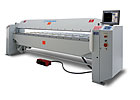
Technology is finding it’s way into smaller and smaller roofing tools and machines can even be taught functions to produce parts so precise the industry calls them “clones.” While computers can address many concerns, high-production machines get regular checkups from in-house personnel through RAS preventive maintenance programs. The payoff for many machines is one roofing job, but it also has to be something for the modern labor force.
“The customer wants a machine tool that does not require a highly skilled operator to produce accurate parts in a timely manner,” said Wester. “That’s where a folder comes in. It is simple to operate, the training period is reasonably short, and the products that are produced and very accurate.”
Training is a significant issue for all manufacturers. Certainly a roofing contractor wants to know that his $85,000 investment is being treated properly and making him money. “The key to the machine’s success is training,” said Kevin Corcoran of Englert Inc. (www.englertinc.com). “What we really prefer to do is go to the first job with you.”
The company not only sells and leases jobsite roll formers but offers the components and tools needed to install metal roofing and gutters. The purchase of a machine is just the beginning for the company, which has warranties and code approvals for its systems. Corcoran also sees portability as a key advantage on the modern jobsite, where some trades find nearly impossible staging areas to work from. Access, shipping damage, theft and do-overs take their toll, but control is probably the biggest reason for contractors to take the plunge into metal, according to Corcoran.
Englert continues to innovate with designers in both Europe and America, like the new RainPro gutter machine. Corcoran, who said it’s the biggest design change in gutters in 50 years, introduced the product because modern houses needed the extra volume. “It handles about 37 percent more water than the gutters today, but it doesn’t look any bigger,” he said.
The portability may open up a new market for metal in the amount of cladding being installed on interior and exterior walls. The Metal Initiative (www.themetalinitiative.com) is a new program to get designers and builders to consider metal for just about any phase of construction. It is sponsored by metal suppliers, producers and associations which have an interest in promoting the benefits of metal. In his frequent travels, Corcoran couldn’t help noticing that nearly all the airports gleam with metal inside and out.
“The cladding business is getting pretty big into metal,” he said, adding that his company is researching how portability may ease production. “That’s really where the savings are going to be in the future. It going to be in job control and labor.”
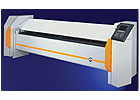
“Sometimes it’s hard to talk to contractors. When they discover you, it’s a different story. When people see you at the show, they often say, “Where have you been?’”
According to Zalal, another innovative tool that catches contractors’ eyes on the show floor is the Disc-O-Bender from Wuko. It’s a handheld, compact, portable bending machine that hems metal sheets from 0 degrees to 90 degrees, and the same piece can then be bent up to 180 degrees. The design allows faster, more accurate hems without extensive training, said Zalal.
“If a wall cap is being installed, you can do it right at the jobsite. You don’t have to waste time going back to the shop,” he said.
Conventions also present a unique opportunity to showcase a company’s entire inventory and let contractors interact with it. Hoisting equipment - particularly a new hydraulic crane package - is another product that Zalal said is popular with attendees, and the urge to make a purchase can become irresistible when a roofing contractor has an open trailer hitch.
“We have a crane you can pull behind a pickup truck,” said Zalal, who usually doesn’t have to take his inventory back with him. “After they see the product in use, they say, ‘We’ve got to have one.’ Then they come back and say they need one on every truck.”
Another way to cut costs is through the coiling operation. Roofing contractors who need a 20-inch wide coil for their portable roll formers are discovering that a decoiling system has a quick payoff. Larry Chandonnet, owner of Engage Machinery (www.engagemachinery.com) in Peachtree, Ga., says that once word got out about how easy it is to make your own 3,000-pound coils, sales shot up 300 percent last year.
“They’re able to cut their lead time down and cut the cost down by having it coiled themselves,” said Chardonnet. “You do it as you need it. If anything, it saves a lot of space.”
Engage Machinery has a system that turns master coils into smaller widths for panels, gutters or flashing. The larger capacity machines reduce coil changing, providing contractors with yet another high-volume tool in its bid to become their own manufacturer. Service and refurbishing all of these metal roofing factories will keep many people busy as bright spots of economic activity sprout up around the country.
Even in times of economic uncertainty roofs are still installed because building owners must protect their investments. Metal continues to increase its market share and may get a boost from fence sitters who will see federal energy tax credits expire at the end of 2008. The innovation continues as metal machinery companies bend to market forces as easily as 24-ounce copper.
“We really think the demand for our products is real. Our expectations are high,” said Stone. Without elaborating any further, he did let on about one bright spot. “I will tell you this: Canada has been on fire for us.”


RAS Systems' swaging machines feature computerized controls designed to produce identical parts automatically.
A tightening construction market makes that versatility more important as innovation continues to simplify training and upgrading. High-tech computer controls and Internet diagnostics allow technicians to turn out quality panels and flashing with a few keystrokes and service the machine as well.
“These are some of the biggest changes in the industry,” said Rick Wester, vice president of RAS Systems, LLC in Peachtree, Ga. (www.ras-systems.com). “The computer with the aid of codes, like bar coding, makes the transfer of information to the machine very simple and this eliminates errors in production.”

The Disc-O-Bender from Wuko is a handheld compact portable bending machine that hems metal sheets up to 180 degrees.
High-Tech Controls
There was a time in American roofing when metal plates were fashioned and installed on site by tin knockers with years of experience. When long, straight panels with durable coatings became available through manufacturers, the construction process changed into assembling pre-engineered parts cut to exact specifications. Now with jobsite roll formers and stationary folders, roofing contractors are finding the benefits in controlling the end product.“Contracts want to be in charge of the manufacturing cycle so they can be in charge of the construction cycle,” said Geoff Stone, president of MetalForming Inc. in Peachtree, Ga. (www.metalforming-usa.com). “Contractors are more and more becoming manufacturers.”
MetalForming built a business on showing the profitability of a sheet metal shop with folders, roll-formers and shears, even breaking the cost of machines into an hourly rate. The tremendous popularity of architectural metal roofing in a booming construction market ensured a large customer base. Now when it seems customers are taking a breather, the metal roofing market is once again changing form to meet consumer demands.
Although he says the last quarter was the company’s best ever, Stone is addressing a lower price point in current customers by retrofitting existing machines. This “extreme makeover” involves taking an old Schechtl or Jorns machine and installing a Pathfinder controller, touch-screen monitor and advanced graphic programming. The result is a fully networked machine that can form thousands of components. Stone says the company has also refurbished a backlog of trade-ins for substantial savings over new models.
MetalForming is also using computers for the integration of management software and accessing the Internet for training new customers, a requirement for each purchase. The 12,000-square-foot warehouse/training center is used for live and Web-based training.
“A lot of bugs are easy to detect with a computer,” said Bill Wilkins, vice president of Operations. “It will allow us to update (machines) quickly.”

MetalForming offers a variety of folders, including the Schechtl Max 3100.
Taking Shape
Computer technology has minimized errors and made training employees easier, according to Wester of RAS Systems. “We have developed a swaging machine that has a computer on it,” he said. “You can program the machine’s speeds, depths and direction in order to produce identical parts each and every time.”Technology is finding it’s way into smaller and smaller roofing tools and machines can even be taught functions to produce parts so precise the industry calls them “clones.” While computers can address many concerns, high-production machines get regular checkups from in-house personnel through RAS preventive maintenance programs. The payoff for many machines is one roofing job, but it also has to be something for the modern labor force.
“The customer wants a machine tool that does not require a highly skilled operator to produce accurate parts in a timely manner,” said Wester. “That’s where a folder comes in. It is simple to operate, the training period is reasonably short, and the products that are produced and very accurate.”
Training is a significant issue for all manufacturers. Certainly a roofing contractor wants to know that his $85,000 investment is being treated properly and making him money. “The key to the machine’s success is training,” said Kevin Corcoran of Englert Inc. (www.englertinc.com). “What we really prefer to do is go to the first job with you.”
The company not only sells and leases jobsite roll formers but offers the components and tools needed to install metal roofing and gutters. The purchase of a machine is just the beginning for the company, which has warranties and code approvals for its systems. Corcoran also sees portability as a key advantage on the modern jobsite, where some trades find nearly impossible staging areas to work from. Access, shipping damage, theft and do-overs take their toll, but control is probably the biggest reason for contractors to take the plunge into metal, according to Corcoran.
Englert continues to innovate with designers in both Europe and America, like the new RainPro gutter machine. Corcoran, who said it’s the biggest design change in gutters in 50 years, introduced the product because modern houses needed the extra volume. “It handles about 37 percent more water than the gutters today, but it doesn’t look any bigger,” he said.
The portability may open up a new market for metal in the amount of cladding being installed on interior and exterior walls. The Metal Initiative (www.themetalinitiative.com) is a new program to get designers and builders to consider metal for just about any phase of construction. It is sponsored by metal suppliers, producers and associations which have an interest in promoting the benefits of metal. In his frequent travels, Corcoran couldn’t help noticing that nearly all the airports gleam with metal inside and out.
“The cladding business is getting pretty big into metal,” he said, adding that his company is researching how portability may ease production. “That’s really where the savings are going to be in the future. It going to be in job control and labor.”

RAS offers the TURBObend folding system.
Convention Wisdom
Another way of gaining interest is the interaction at conventions. A.G. Zalal, president of North American Bocker (www.nabocker.com), said that hands-on education is the key when it comes to introducing contractors to new equipment. That’s why trade shows like the International Roofing Expo are great opportunities for Zalal to demonstrate new products, such as the cordless slate cutter he has in development. He had the prototype on display at last year’s IRE, and several contractors threatened to walk away with it.“Sometimes it’s hard to talk to contractors. When they discover you, it’s a different story. When people see you at the show, they often say, “Where have you been?’”
According to Zalal, another innovative tool that catches contractors’ eyes on the show floor is the Disc-O-Bender from Wuko. It’s a handheld, compact, portable bending machine that hems metal sheets from 0 degrees to 90 degrees, and the same piece can then be bent up to 180 degrees. The design allows faster, more accurate hems without extensive training, said Zalal.
“If a wall cap is being installed, you can do it right at the jobsite. You don’t have to waste time going back to the shop,” he said.
Conventions also present a unique opportunity to showcase a company’s entire inventory and let contractors interact with it. Hoisting equipment - particularly a new hydraulic crane package - is another product that Zalal said is popular with attendees, and the urge to make a purchase can become irresistible when a roofing contractor has an open trailer hitch.
“We have a crane you can pull behind a pickup truck,” said Zalal, who usually doesn’t have to take his inventory back with him. “After they see the product in use, they say, ‘We’ve got to have one.’ Then they come back and say they need one on every truck.”
Another way to cut costs is through the coiling operation. Roofing contractors who need a 20-inch wide coil for their portable roll formers are discovering that a decoiling system has a quick payoff. Larry Chandonnet, owner of Engage Machinery (www.engagemachinery.com) in Peachtree, Ga., says that once word got out about how easy it is to make your own 3,000-pound coils, sales shot up 300 percent last year.
“They’re able to cut their lead time down and cut the cost down by having it coiled themselves,” said Chardonnet. “You do it as you need it. If anything, it saves a lot of space.”
Engage Machinery has a system that turns master coils into smaller widths for panels, gutters or flashing. The larger capacity machines reduce coil changing, providing contractors with yet another high-volume tool in its bid to become their own manufacturer. Service and refurbishing all of these metal roofing factories will keep many people busy as bright spots of economic activity sprout up around the country.
Even in times of economic uncertainty roofs are still installed because building owners must protect their investments. Metal continues to increase its market share and may get a boost from fence sitters who will see federal energy tax credits expire at the end of 2008. The innovation continues as metal machinery companies bend to market forces as easily as 24-ounce copper.
“We really think the demand for our products is real. Our expectations are high,” said Stone. Without elaborating any further, he did let on about one bright spot. “I will tell you this: Canada has been on fire for us.”
Looking for a reprint of this article?
From high-res PDFs to custom plaques, order your copy today!




